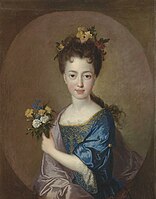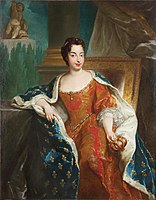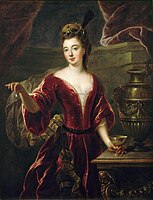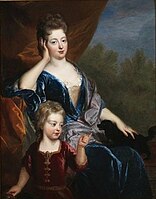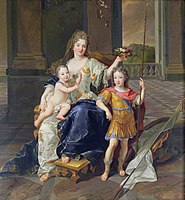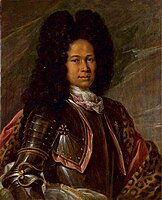François de Troy
François de Troy | |
|---|---|
 Portrait of Troy from 1703 by his student and Academy member Alexis Simon Belle | |
| Born | February 1645 |
| Died | 1 May 1730 (aged 85) |
| Known for | Painting |
| Children | Jean-François de Troy |
| Patron(s) | Courts of James II of England and James Francis Edward Stuart in exile, French court |
| Director of the Académie de Peinture et de Sculpture | |
| In office 1708–1711 | |
| Monarch | Louis XIV |
| Preceded by | Jean Jouvenet |
| Succeeded by | Corneille Van Clève |
François de Troy (February 1645 – 1 May 1730
Early life
One of a family of artists, Troy was born in Toulouse, the son of Antoine Troy (bapt. 28 July 1608 – 15 September 1684), a painter in that city,[3] and Astrugue Bordes. François Troy and was the brother of the painter Jean de Troy (4 April 1638 – 25 June 1691).[4] Troy was taught the basic skills of painting by his father, and perhaps also by the more worldly Antoine Durand.[3][5]
François de Troy is not to be confused with his son, the portrait painter Jean-François de Troy (1679–1752), who studied under him.[6]
Career
At some time after 1662, Troy went to Paris to study portrait painting under Claude Lefèbvre (1633–1675) and Nicolas-Pierre Loir (1624–1679].[5] A. P. F. Robert-Dumesnil states that this occurred when Troy was aged twenty-four.[3]
In 1669, Troy married his master Nicolas-Pierre Loir's sister-in-law, Jeanne Cotelle.[5]
In 1671, he was approved (agréé) by the
Troy's early known works include tapestry designs for
In the 1670s, he became friendly with Roger de Piles, who introduced him to Dutch and Flemish painting, and after the death of Claude Lefebvre in 1675, Troy changed his direction to become a portrait artist, aiming at commissions from Lefebvre's former clients. In 1679 he was commissioned to paint a portrait of the Swedish ambassador Nils Bielke, and in 1680 that of Maria Anna Victoria of Bavaria, shortly after her marriage to Louis of France, Dauphin of France, the heir to the French throne, on 7 March 1680.[5] Troy became a successful painter of fashionable single and group portraits.[7] His clients included Madame de Montespan, her son by the king, Louis Auguste, Duke of Maine, and his wife Louise Bénédicte de Bourbon.[5]
As a result of such commissions, Troy was able to work continuously in court circles for almost fifty years. He was admired for his ability to capture the upper classes and their preoccupation with manners and fashion.[5] Perhaps more importantly, he was said to have the ability to make any woman look beautiful, which made him sought after by all women.[8]
In the 1690s, Troy became the principal painter to the court of King James II in exile at Saint-Germain-en-Laye, where he was the master of Alexis Simon Belle.[9]
By the years 1698 to 1701, a period of peace between France and Great Britain, Jacobites could cross the English Channel carrying portraits of
In 1698, he was appointed a Professor of the Académie Royale, and in 1708 became its Director.[10][11]
Troy was an
Apart from his son, Jean-François, Troy's other students included André Bouys[3] and John Closterman.
He died in Paris at the age of eighty-five.[3]
Work
The portraits painted by Troy include (see image gallery) -
- Richard Talbot, 1st Earl of Tyrconnell, 1690[12]
- Lady Mary Herbert, Viscountess Montagu, as Diana, c. 1692[13]
- Jean de la Fontaine[14]
- Jules Hardouin-Mansart(1646–1708)
- Élisabeth Jacquet de La Guerre (1665–1729)[15]
- Princess Louisa Maria Stuart(1692–1712), about 1705
- Portrait d'un couple en Vénus et Pâris, 1691, 150 cm by 120 cm, now in the Louvre[1]
Gallery
- Paintings by François de Troy
-
Jules Hardouin Mansart
-
Princess Louisa Maria Stuart, about 1705
-
Portrait of a young boy with a dog
-
The Feast of Dido and Aeneas, 1704
-
Charles Mouton, 1690
-
Friedrich Baron de Knabenau,1670
-
The Dauphine of France, after 1690
-
Cleopatra
-
The Count of Brionne's wife, Marie Madeleine d'Epinay and son the Prince of Lambesc, 1697
-
The Duchess of La Ferté-Senneterre with the Duke of Anjou on her lap and the Duke of Brittany, 1710
-
Portrait of a mulatto in armour(c1680-1730
References
- Cailleux, Jean, Some Family and Group Portraits by Francois de Troy (1645–1730) in The Burlington Magazine, vol. 113, no. 817 (April 1971), pp. i-xviii
- Brême, Dominique, François de Troy 1645-1730 (Paris, ed. Somogy, Editions d'art, 1997, 199 pages, ISBN 978-2-85056-278-5)
Notes
- ^ a b c Portrait d'un couple en Vénus et Pâris at the web site of the Louvre (accessed 15 February 2008)
- ^ Benezit Dictionary of Artists. Vol. 13, Sommer–Valverane. Paris: Éditions Gründ. 2006. pp. 1211–1212.
- ^ a b c d e f g Robert-Dumesnil, Alexandre Pierre F., Le peintre-graveur français, ou Catalogue raisonné des estampes gravées par les peintres et les dessinateurs de l'ecole française, vol. 7 (1844) p. 337 online at books.google.com (accessed 15 February 2008)
- ^ Brême, Dominique (1997). François de Troy 1645–1730. Paris. pp. 11–18.
{{cite book}}: CS1 maint: location missing publisher (link) - ^ a b c d e f g h François de Troy at safran-arts.com (accessed 15 February 2008)
- ^ François de Troy, French Baroque Era Painter, 1645-1730 at artcyclopedia.com (accessed 15 February 2008)
- ^ Bordeaux, Jean-Luc, Jean-Francois de Troy, Still an Artistic Enigma: Some Observations on His Early Works in Artibus et Historiae, vol. 10, no. 20 (1989), pp. 143-169
- ^ Robert-Dumesnil, op. cit.: "Possédant l'art de rendre toutes les femmes belles, son pinceau flatteur le fit rechercher de toutes les dames et lui procura une grande vague à la cour."
- ^ Oxford Dictionary of National Biography(Oxford University Press, September 2004
- ISBN 0-543-93157-9), page 208online at books.google.com (accessed 16 February 2008)
- ISBN 978-1-4094-5742-8.
- ^ Richard Talbot, 1st Earl of Tyrconnell portrait at npg.org.uk (accessed 15 February 2008)
- ^ National Trust acquisitions 2003-2004 at findarticles.com (accessed 15 February 2008)
- ^ Portraits of Jean de la Fontaine at lafontaine.net (accessed 15 February 2008)
- ^ Notes on the Elisabeth Jacquet de la Guerre Portrait Archived 25 July 2008 at the Wayback Machine at earlywomenmasters.net (accessed 15 February 2008)
External links
- François de Troy at culture.gouv.fr
- François de Troy at the web site of the National Portrait Gallery, London


